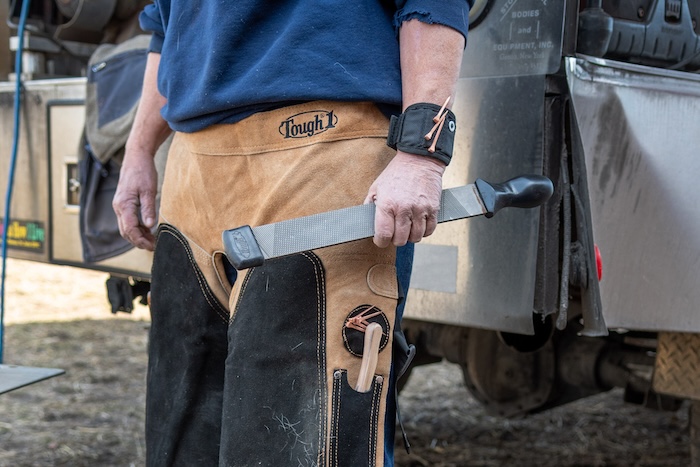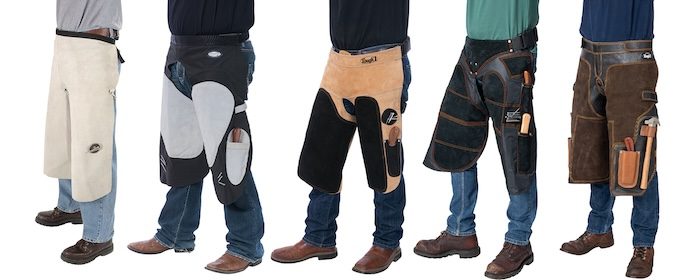As a farrier, you already know that the farrier apron, also called farrier chaps, are a required piece of equipment—you need an indispensable tool to protect your legs while also offering a place to hold tools within reach. In the beginning, the farrier apron was a one-piece design made of thick leather, with a waist belt and a strap at the top of the thighs. Now, farrier chaps are available in a variety of materials, offering different amenities such as multiple tool pockets, strong magnets, padding at the top of the thigh and so much more.
What should you look for when you’re investing in a new pair of farrier chaps?

Materials
The farrier apron provides a barrier between your body and the potential damage a horse’s hoof can do. The outer material needs to be strong to handle scrapes from hooves and potential punctures from shoeing nails, but also flexible to not restrict motion.
- Leather – The standard for aprons and chaps, using a full-grain leather for your apron provides durability while also offering protection from punctures and scraps. Depending upon the thickness and quality of the leather, it may take some time to fully break-in the apron to mold across your legs, but once it does, your apron is almost like a second skin.
- Nylon – Utilizing a heavy-duty canvas material allows for a more economical choice for an apron, while also offering the ability to quickly form to the farrier’s body faster than breaking in a pair of all-leather chaps. This material is also lighter weight than leather. The same features, such as a tool hook, pockets, leg straps and adjustable waist, can also be found on a nylon apron.
- Combination – Newer models of farrier aprons offer the versatility of leather and nylon combined. The leather provides the durability while the nylon offers more flexibility, utilizing an apron made from both materials is more of a mid-price option for farriers.

Features
Typically, farriers aren’t looking for anything fancy when it comes to their chaps. While this means no fringe or shiny material required, some extras that might be desired could include a lower back support pad, extra small pockets for knives and adjustable leg straps and waist band. An apron provides efficiency and a better workflow for the farrier by protecting the farrier’s clothing while also providing a “third hand” to hold smaller tools and nails.
From the top down, it’s important to know what features each type of farrier apron offers and what would fit best for your body and your business.
- Leg straps: For safety reasons, leg straps should allow for quick disconnection, should a freak incident occur where the horse’s hoof slips into the leg of your chaps, so check the type of connection (clips, snaps, hook-and-loop closure, etc.) when comparing aprons. These straps should also offer adjustability for a more secure and snug fit.
“You don’t want a leg strap that hangs too loose, and you don’t want a leg strap that is so strong it won’t come apart if you’re in a freak accident,” advises Ann Griffin, a farrier for 30 years, based in Central Indiana. “There needs to a ‘quick release’ action in all parts of your apron—waist and legs.” - Waist strap: An adjustable waistband that allows for flexibility is priority to ensure proper fit and that your apron will stay in place while holding the extra weight of your tools. These also can be designed with a breakaway method for increased safety.
- Tool Storage: For those looking for more efficiency in their workday, tool pockets and hanging straps allow farriers to stow their most used tools within an easy reach. Pockets for your hoof knives located on the outside of your leg and a strap for hanging a small nail hammer can take away the concern of having to reach to find your tools.
- Magnets: Some aprons might also include a strong magnet near the tool pockets to allow you to stow extra nails for easy reach, however you should be aware of where the magnet hits on your body so you’re not always knocking the nails off the magnet and into the dirt.

Choosing the Right Apron
If you’re just starting to get your business running, you can start in one type of apron and then to later move up into a more expensive pair or even go custom. It may take some time to find the right style to handle the length of the day and provide the convenience you need to be more efficient.
Consider the type of work you will be doing as a farrier. If your focus is barefoot work, you might not need all the pockets and hooks for tools, and you might not need to worry about a thicker leather that deters nail punctures.
A farrier’s apron is a vital part of your safety, as well as comfort and assistance in your job. It is an essential tool to simplify your work. So, take the time to try different types of aprons/chaps until you find the right fit for you.
To see the full line of Tough1 Farrier Chaps and Aprons, visit Tough1.







